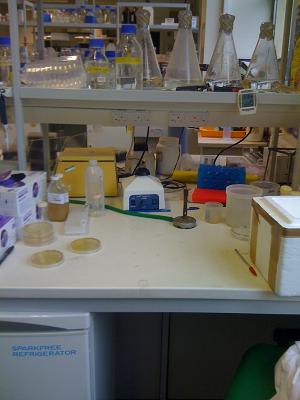Team:BCCS-Bristol/Wetlab
From 2010.igem.org
iGEM 2010
Contents |
Subpage Structure
Team:BCCS-Bristol/Wetlab/Part_Design
Team:BCCS-Bristol/Wetlab/Beads
Team:BCCS-Bristol/Wetlab/Improvements
Team:BCCS-Bristol/Wetlab/Experiments
Team:BCCS-Bristol/Wetlab/Safety
Team:BCCS-Bristol/Wetlab/Project_Results
Team:BCCS-Bristol/Wetlab/Image_Gallery
Links to old pages
Team:BCCS-Bristol/Wetlab/Notebook
Team:BCCS-Bristol/Wetlab/BioBricks
Team:BCCS-Bristol/Wetlab/Lab_photos
Wet lab
The wet lab team have been focussing on further characterising the PyeaR promoter submitted by Edinburgh last year and on creating our own new Biobricks to engineer E. coli to produce GFP in response to nitrates.
We have also been examining different methods of encapsulating our bacteria to create pellets that could be easily spread by farmers on fields, as well as looking at signal detection and E. coli survival on soil.
For a more in depth view of what we have done so far, click on the Notebook section.
For a complete list of the biobricks used during our project, plus a brief description on their use, click here.
Safety Issues
As the idea of communication between a certain population (in this case E.coli) could raise issues in health and safety of the general public the following precautions were taken during the implementation of the project in the laboratory:
- Novel proteins handled (FhuA,OsmE,Fiu) were derived from DNA by gene cloning with PCR from E.coli MG1655 a laboratory strain with no toxic implications.
- Novel proteins handled where screened from the literature to ensure that they will have no toxicity effects.
- Experiments were implemented in a Level 1 Laboratory with access only by trained individuals.
- Students involved in experimental work in the laboratory were trained to an appropriate level to apply relevant techniques and use relevant equipment and where suitable were supervised whilst carrying out laboratory work.
- Laboratory workers were always clothed in appropriate manner (lab coat, gloves, safety spectacles).
- Laboratory workers sterilised their hands before and after laboratory work and before entering and exiting the lab at all times.
- No bacterial cultures exited the laboratory unless they were suitably packaged and accompanied by one of the team members whilst in transport and this only occurred where it was necessary to transport cultures from one laboratory to another.
- No purified DNA or biological material was left unattended at any time, and all DNA and biological material was suitably stored according to Level 1 Laboratory rules.
- Biosafety guidelines where followed under the BCCS-Bristol iGEM'09 supervising team and such guidelines fall within the description of a project that holds approval by the iGEM supervisor Dr.Nigel Savery.
 "
"
